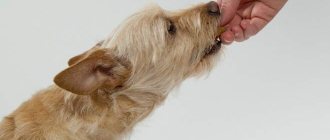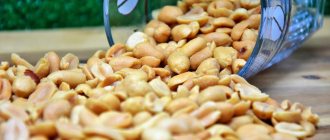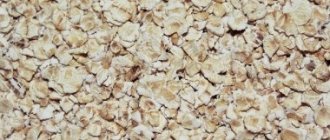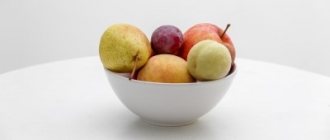The dog's diet should be as natural and varied as possible, so porridge is an integral part of the diet and should make up about 30-40%. Cereals supply your pet's body with complex carbohydrates, zinc, magnesium, iron, potassium and B vitamins.
But not every cereal will be healthy for a dog. When it comes to semolina, owners often differ in their opinions; some try to avoid using semolina to feed their dogs, while others, on the contrary, feed their pets with such food too often.
Is there any benefit?
Semolina is processed remains of wheat grain. With such processing, only the central part of the grain remains, as a result of which the cereal loses almost all its vitamins, minerals and fiber.
However, it is precisely the low fiber content that makes semolina necessary for feeding dogs with problems with the digestive tract.
In addition, semolina is the purest carbohydrate, which is ideal for feeding puppies or small animals. But it should be introduced into your pet’s diet only on the recommendation of a veterinarian.
Features of dog digestion
Based on the type of digestive system, dogs are classified as omnivores. Over 10,000 years of living next to humans, she learned to digest sugar, fiber and starch. This fact is confirmed by genetic studies.
Peculiarities of digestion depend on the climate, geography and culture of the people in whose surroundings the breed was formed, and other factors. For example, many European Shepherds have survived for centuries on a meager, low-protein diet. In Serbia, herding dogs were fed mainly with cornmeal and semolina porridge, a small amount of meat, offal, and vegetables. Not a single native Japanese breed can live happily on such a diet; its digestive system is tuned to meat, fish, rice, and vegetables.
Not all cereals are equally healthy
It is impossible to definitively answer the question of which porridge is best for dogs. There are general recommendations regarding feeding, but first of all you need to take into account the individual digestive characteristics and taste preferences of your pet. The digestibility of porridge can be judged by the amount of undigested cereal in the feces. If there is a lot of it, it is better to discard the product. Also, cereals should be immediately removed from the diet if they cause digestive upset.
Why can't you give?
Semolina can rightfully be called a rather specific product - although it has some benefits for the body, there are also disadvantages.
- Frequently feeding a dog semolina porridge leads to excess weight gain.
- Semolina, like pasta, contains gluten, which has a cumulative effect, and if consumed excessively, it can cause severe allergies.
- Semolina can also significantly increase blood sugar levels, which makes it absolutely unacceptable for pets with diabetes.
Therefore, semolina porridge is strictly not recommended for sedentary dogs prone to gaining excess weight and predisposed to allergic reactions or autoimmune diseases (white breeds).
What cereals should you avoid?
Some cereals are strictly contraindicated for dogs. Avoid feeding your pets the following cereals:
- Manna. This food is useless for dogs, as it does not contain valuable microelements. Eating semolina clogs the stomach and leads to obesity.
- Corn. This product is very poorly absorbed and causes bloating.
- Yachneva. Such cereals create a large load on the stomach, cause a feeling of heaviness in the stomach and lead to constipation.
- Perlova. This porridge is almost not absorbed by the dog’s body and often causes allergies.
In addition, dogs should not be given any milk cereals. Many pets are very lactose intolerant. In the practice of veterinarians, there were often cases when milk caused volvulus in animals. This is an unnatural product for an adult dog. After all, in nature only puppies feed on milk.
With milk or water?
Cooking semolina with milk is only allowed for feeding puppies. The fact is that milk contains a lot of lactose, which is easily digestible only by puppies; Adults run the risk of getting various problems with the gastrointestinal tract.
It is preferable to cook any porridge for a dog in water or broth, but when using meat, it is advisable to throw it into the prepared porridge. Also, it should not be too liquid or thick.
Important! In no case should you add salt or sugar - the dog gets them in the required quantities from other products (subject to a complete balanced diet), and an overdose of these substances will lead to extremely negative consequences, even death.
How to cook?
In order to properly prepare semolina for a dog, you will need:
- semolina – 250 g;
- water – 2 l;
- meat/minced meat/offal – 250 g.
Boil water, then slowly add the cereal, stirring constantly. Cut the meat into small pieces, add to the porridge and cook for about 5-7 minutes, stirring occasionally. Meat can be used either raw or lightly boiled, with the exception of pork - it must be well cooked before adding.
The healthiest porridges
Dog handlers consider it acceptable to give dogs porridge made from buckwheat and rice. Millet and oatmeal are less useful. When choosing cereal, it is important to consider the size and breed of your pet.
Large breeds of dogs, in the absence of contraindications, can eat all of the above grains. For example, the German Shepherd is able to adapt well to any menu.
Small and decorative breeds of dogs need to select porridge very carefully and carefully. Dog handlers recommend giving them very small portions of buckwheat. In this case, you need to monitor the animal’s well-being. If your pet's ears become itchy or red, this indicates an allergy. In this case, porridge should be completely avoided.
Next we will talk in more detail about the healthiest cereals for dogs.
What to do if you vomit after it?
If after eating semolina porridge (or in any other case) the dog vomits, it is necessary to provide it with first aid.
- Ensure rest - try to put your pet down and cover with a blanket if he is shaking.
- Encourage and calm the pet - he should feel cared for and needed; Under no circumstances should you allow yourself to worry or feel guilty.
- the soiled fur with a rag or towel soaked in warm water - carry out the procedure only when the dog is calm; if the animal feels uncomfortable, it is better to wait a little.
- Place disposable diapers or unnecessary towels in case of repeated vomiting.
- Carefully monitor the animal for signs of impending vomiting or deterioration of the condition - these include gagging, stiffness, immobility, prolonged aimless walking around the room.
If the pet's condition has returned to normal and vomiting does not recur, it is recommended to give the pet a rest. In addition, for the first time after vomiting you will have to adhere to some nutritional recommendations.
- It is not advisable to feed the animal for 12 (8-10 for young dogs and puppies) hours after vomiting, so as not to provoke repeated attacks and not to overload the irritated stomach.
- Solder with water - every hour you need to give 2 tsp per 1 kg of weight. Give water until the dog starts drinking on its own. Also, you can give a rehydron solution (according to the instructions), according to the same scheme as water.
- If your pet refuses to drink, you need to wipe its gums with a napkin/rag soaked in water . You can also try giving ice cubes or warm herbal tea (chamomile, ginger, mint).
- After 12 (8-10) hours, you need to start giving light, easily digestible food - boiled potatoes, boiled skinless chicken, beef cutlet, boiled rice or pressed cottage cheese. Give food 2-3 tsp. each hour.
- Follow this dietary diet for 24 hours , then carefully begin to introduce regular food - mix dietary and regular food in equal proportions for the first feeding, then, with each feeding, gradually reduce the proportion of dietary food.
- Under no circumstances should you give any medications without the permission of your veterinarian.
It is worth understanding that vomiting can be caused not only by poorly prepared or poor-quality food, but also be a symptom of various serious pathologies.
Therefore, if the following signs are detected, it is urgent to show the animal to a specialist:
- pale skin and gums;
- atypical behavior, depression;
- weakness, loss of strength;
- difficulty walking or standing up;
- problem raising the head;
- repeated or recurring vomiting, inability to retain water.
In addition, if your dog has any chronic diseases, you should also consult with a specialist before restricting its food.
Buckwheat
This is the healthiest porridge for a dog's body. It contains minerals that strengthen bones and have a beneficial effect on blood vessels.
Lost weight: what Sofia Tarasova sacrificed for the sake of “VIA Gra” (new photos)
“We are still friends”: Derevianko commented on the breakup with his wife
"Dad is offended." Agata Muceniece about her relationship with Priluchny after the divorce
Cover the cereal with water and leave overnight. In the morning, drain the liquid along with the husks. Then mix buckwheat and water in a 1:2 ratio. Cook the porridge for 15 minutes, and then leave in the pan for about 20 minutes.
The porridge is prepared without salt or seasonings. After cooking is complete, you can add a little vegetable oil to the warm buckwheat.
What to replace semolina with?
Since semolina is not suitable for many dogs and should not be given too often, the diet must be varied with other, healthier grains.
- Buckwheat. The most healthy cereal, rich in plant proteins, iron, magnesium, calcium and B vitamins. Necessary for strengthening the cardiovascular system, immunity and improving metabolism.
- Rice. Contains vitamins E and group B, magnesium, calcium, iron. This porridge is indispensable for poisoning.
- Millet. Rich in vitamins A, C, D, B, magnesium, iodine and zinc. But not everyone can eat wheat groats - due to the high content of starch and flour, millet is not recommended for low-active dogs.
- Yachka. A source of vitamins A, C, D, E and group B. Improves the functioning of the gastrointestinal tract and significantly replenishes energy balance.
- Oatmeal/rolled oatmeal. Source of magnesium, potassium, calcium, sodium and vitamins A, E, B1 and B2. Contraindicated in animals suffering from urolithiasis.
You should not use only one type of cereal for constant feeding - porridge should be alternated, and the diet should be diluted with other necessary products.
How to give milk
Puppies can be fed milk without any problems from the age of 20 days, and newborn cubs, if the nursing dog does not have enough milk, even on the 3rd day. Their body easily copes with the product.
In dogs of large breeds, a decrease in lactase production occurs from three months of age, in small dogs - from one and a half months.
Goat's or cow's milk in its pure form can only be given to pets until they reach this age.
To bring the composition of goat or cow milk closer to dog milk, add 1 tablespoon of cream and 1 beaten quail egg yolk (0.5 liter). For puppies older than 1.5 - 3 months, it is advisable to cook milk porridge. They are absorbed better.
If the pet does not lose its love for milk in adulthood, then you can do the following:
- At the pet store, buy a product with a reduced lactose content; it can sometimes be given to our smaller brothers.
- If tolerated well, milk can be given, diluted with water, but not daily. It is better to replace cow's with goat's.











